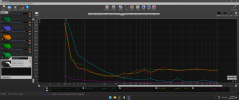Hello everyone, hope your day is going well 
I am currently building some acoustic treatment for my office/home studio space. I had gone shopping in person at multiple places looking for some nice looking, breathable and affordable fabric to wrap the panels in, but then found a great deal online.
The fabric finally was delivered, but after inspecting it I noticed that the fabric weave was actually much tighter than expected. The most common advice that seems to be given online regarding suitable fabric is to do the "breath test".....I could barely exhale/blow through this stuff at all!
Being very concerned that this fabric would undermine all the efforts I was making to build these panels I had to come up with something to put my mind at ease, so I run some measurements using my UMIK-1 and REW. I took measurements with the mic at listening position, and also at the first refection points of the rooms side walls since I imagined the angle could increase high frequency reflectivity. Measurements were taken with the fabric zip tied over the end of the UMIK, and also with fabric off.
I was surprised to see that all measurements taken were all exactly the same, within margin of error.
So my question is, would I be wrong in assuming that since the measurements are all the same, my fabric is not actually reflecting in the high frequencies? Am I missing something here?
I am currently building some acoustic treatment for my office/home studio space. I had gone shopping in person at multiple places looking for some nice looking, breathable and affordable fabric to wrap the panels in, but then found a great deal online.
The fabric finally was delivered, but after inspecting it I noticed that the fabric weave was actually much tighter than expected. The most common advice that seems to be given online regarding suitable fabric is to do the "breath test".....I could barely exhale/blow through this stuff at all!
Being very concerned that this fabric would undermine all the efforts I was making to build these panels I had to come up with something to put my mind at ease, so I run some measurements using my UMIK-1 and REW. I took measurements with the mic at listening position, and also at the first refection points of the rooms side walls since I imagined the angle could increase high frequency reflectivity. Measurements were taken with the fabric zip tied over the end of the UMIK, and also with fabric off.
I was surprised to see that all measurements taken were all exactly the same, within margin of error.
So my question is, would I be wrong in assuming that since the measurements are all the same, my fabric is not actually reflecting in the high frequencies? Am I missing something here?



